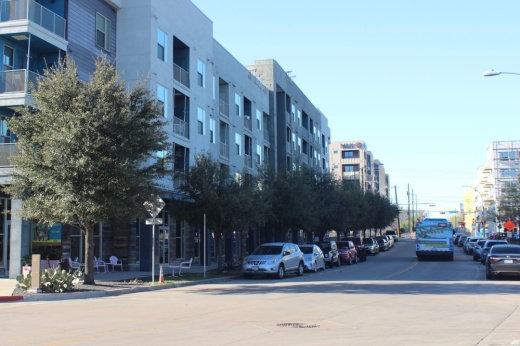City Council is readying to vote March 9 on a new framework from Capital Metro aimed at guiding future development around nearly 100 proposed rail and bus stops across Austin, work that could shape how transit-connected pockets of the city grow over the decades to come.
Council's push to establish a blueprint for equitable transit-oriented development, or ETOD, stretches back to voters' approval of the Project Connect transit system plan and related tax hike in November 2020. Following initial planning by CapMetro, city officials are ready to move forward on a draft ETOD strategy to be further shaped by residents as Project Connect's arrival draws closer.
Council's upcoming vote to accept that draft plan for Austin would launch a year-plus of additional review and public engagement on the topic. It would also start TOD-related amendments to both the city's land development code and its Imagine Austin comprehensive plan, a long-range vision document that currently does not account for Project Connect or its potential community effects.
The council ETOD vote would also jump-start more detailed planning work in a select handful of future transit station areas identified as early priorities: two Project Connect hubs to the north and south of downtown, and a selection of bus and rail stops in Northeast Austin.
CapMetro planners have already begun soliciting input on the North Lamar and South Congress transit centers and will continue to do so; more information is available from CapMetro's website.
The city defines ETOD as a community development framework for areas around Project Connect routes aimed at supporting Austinites of varying backgrounds and incomes, especially those harmed by past government decisions related to land use and transportation.
District 1 Council Member Natasha Harper-Madison, a longtime supporter of Austin's ETOD work, said she hopes to see the plan address historically racist infrastructure policy decisions ahead of what she and others label as a "generational" transit venture.
“This equitable transit-oriented development is intended to address the wrongs of the past; the slow-to-respond in the middle where we’re retrofitting a major metropolitan city with our transit infrastructure; to today where we all have similar investments in what our city looks like going forward," she said during a March 2 council committee review of the plan.
Considering ETOD
Since Austinites approved Project Connect in 2020, the city has only seen more development and an ongoing population boom. And even without final plans for new rail lines and rapid bus routes in place, areas along the proposed system are building up—without any formal city- or community-backed guidelines in place.
“These corridors and station areas are already seeing redevelopment interest today, so getting ahead of that with updated city policy and procedures is key to shaping equitable outcomes and cohesively supporting transit investments and community members," said Rosie Truelove, director of the city housing department.
Austin already has nine TOD areas identified, although only three along the Red Line—Plaza Saltillo east of downtown, MLK Station in East Austin and Crestview Station to the north—have established regulating plans yet.
Officials and staff said they believe a final plan is now needed to help guide budding station areas, especially given a relative lack of success in achieving the city's transit-oriented goals so far.
In the past decade, city staff said the historically diverse areas around Plaza Saltillo and MLK Station have seen active displacement of nonwhite residents and families alongside an influx of more single, white residents. And despite being served by bus and rail service, staff reported that use of transit in those areas has plummeted by as much as 73%. Those changes came at a time when a significant amount of new development, including housing, had poured into those areas.
"These shifting demographics and commuting patterns are not what we'd hope to see out of our TODs, which is another reason that we're looking at a new approach for ETODs," said Warner Cook, a principal planner in the housing department.
In addition to the involvement of displacement prevention in new ETOD plans, Project Connect is also moving ahead with $300 million dedicated to helping residents living near bus and rail lines avoid being pushed out. Tens of millions of dollars have been spent already with more work underway to distribute further displacement funding over the coming years.
Planning review
Council and staff members reviewing the ETOD framework March 2 were careful to point out that the upcoming vote does not cement any new development rules in stone, and is only a first step in setting long-range ETOD policy. The planning document will likely see many revisions in the months ahead covering issues from the level of focus individual neighborhoods could receive to the overall scope of the plan itself.
Several community partners invited by City Council to the March committee review also produced varying views on the best way to move forward. Speakers shared different ideas about community engagement, parking space requirements, and partnering with other entities including the federal government to ensure Austin and Project Connect have the resources they need.
Jake Wegmann, an associate professor at The University of Texas at Austin specializing in community planning, also said Austin should better focus its efforts—including through city funding mechanisms to "stockpile" tax collections for local improvements as ETOD-area property values grow. Wegmann also suggested that the current slate of almost 100 ETOD locations, many of which are based around bus stops, could be reduced to center the plan more on prime areas.
“TOD's really hard, and in my view better to do less in the most promising locations and to do it well, rather than try to do everything and then risk not accomplishing very much," he said.
City Council is scheduled to vote on the ETOD plan March 9. If approved, city staff said the next stages of the process will new run through late 2024.





